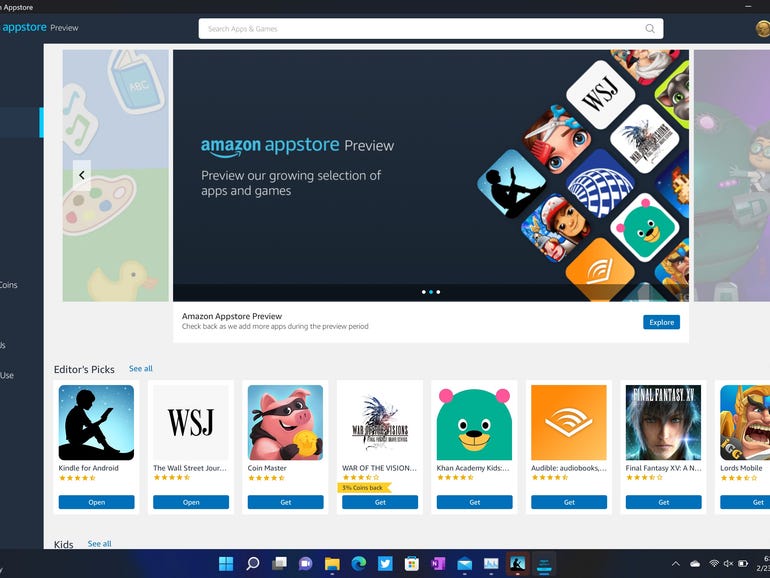For nearly a decade, Microsoft product planners have been chasing the dream of running Android apps on Windows. Last June, as part of the Windows 11 announcement, the company went public with its intentions. And since February 2022, these plans have merged into one shipping feature.
After installing Windows Subsystem for Android on several test PCs, I can confirm that it works as advertised. But as with Windows 11 itself, system requirements (and geo-restrictions) mean many users aren’t able to try out the new feature for themselves.
If you’re one of those who can install and run the necessary stuff, prepare to be disappointed with the extremely limited selection of apps. There’s a good reason for the rarity, though; Android functionality on Windows (which is still officially in preview) does not use Google’s version of Android, nor does it provide access to the Google Play Store’s huge collection of apps.
Instead, Windows Subsystem for Android runs a virtualized version of Android based on the Open Source Android Project, with apps provided through the Amazon Appstore.
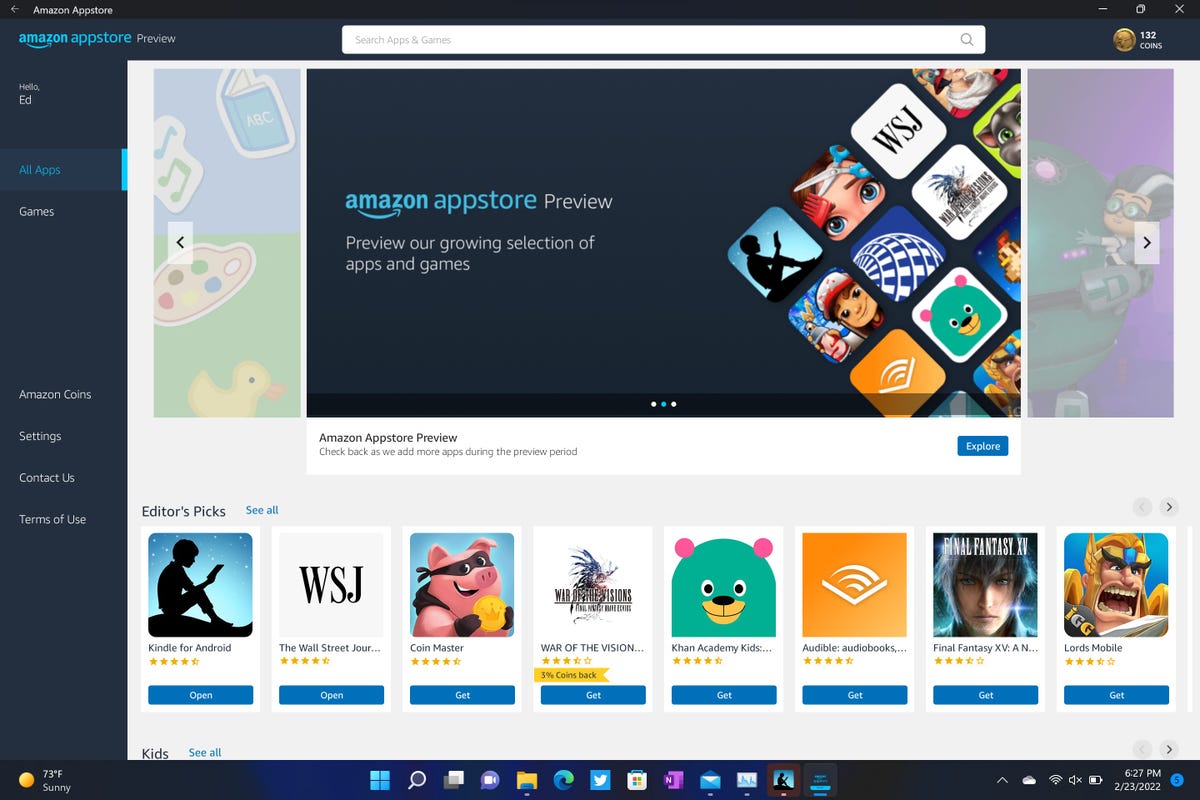
The Amazon Appstore has the Kindle app, but not much else.
Amazon
Although there are over 1,000 apps in the Amazon Appstore, the vast majority are games. The only two flagship apps available are, naturally, from Amazon: the Kindle app, for reading e-books purchased from Amazon, and the Audible app, for listening to audiobooks. On a Windows 11-powered tablet like the Surface Pro X or Surface Pro 8, running either app lets you use your expensive laptop as if it were a Amazon Fire tablet.
Which is…not exactly a compelling proposition to potential buyers.
Also: Want to run Android apps on Windows 11? You need 8GB of RAM but should have 16GB, says Microsoft
The Amazon Appstore did not stock any of the apps I regularly use on Android devices. I couldn’t find any home automation utility to control the lights, thermostat, and other smart home features I use every day. There were no music services (not even Amazon Music), no financial tools, and only a few news-related apps: one for the the wall street journalanother for Jeff Bezos Washington Post, yet another for the sportsmen Launderer’s report. I was surprised to see an app for the controversial far-right cable network Newsmax.
What can you expect if you enable this feature on your own PC? I have the details here.
Will my PC run Windows Subsystem for Android?
Not all PCs can take advantage of this feature. For now, Windows Subsystem for Android is a US-only feature, although that will no doubt change in future updates. In addition, your PC must meet the following system requirements:
- Windows 11 version 22000.0 or higher, any edition
- Microsoft Store version 22202.1402.0 or later
- Architecture: X64 or Arm64
- Processor: 8th Gen Intel Core i3 or later, AMD Ryzen 3000 or later, Qualcomm Snapdragon 8c or later
- Memory: at least 8 GB of RAM (16 GB recommended)
- Storage: an SSD drive
- Virtualization: enabled in hardware
You don’t need to search your system specs to see if your device is compatible. As with Windows 11, an automated compatibility checker is available. Open this support page: install mobile apps and the Amazon Appstore. Click the Get The Amazon Appstore link, which will prompt you to open the Microsoft Store app and find the Amazon Appstore page. Scroll down to check compatibility details.
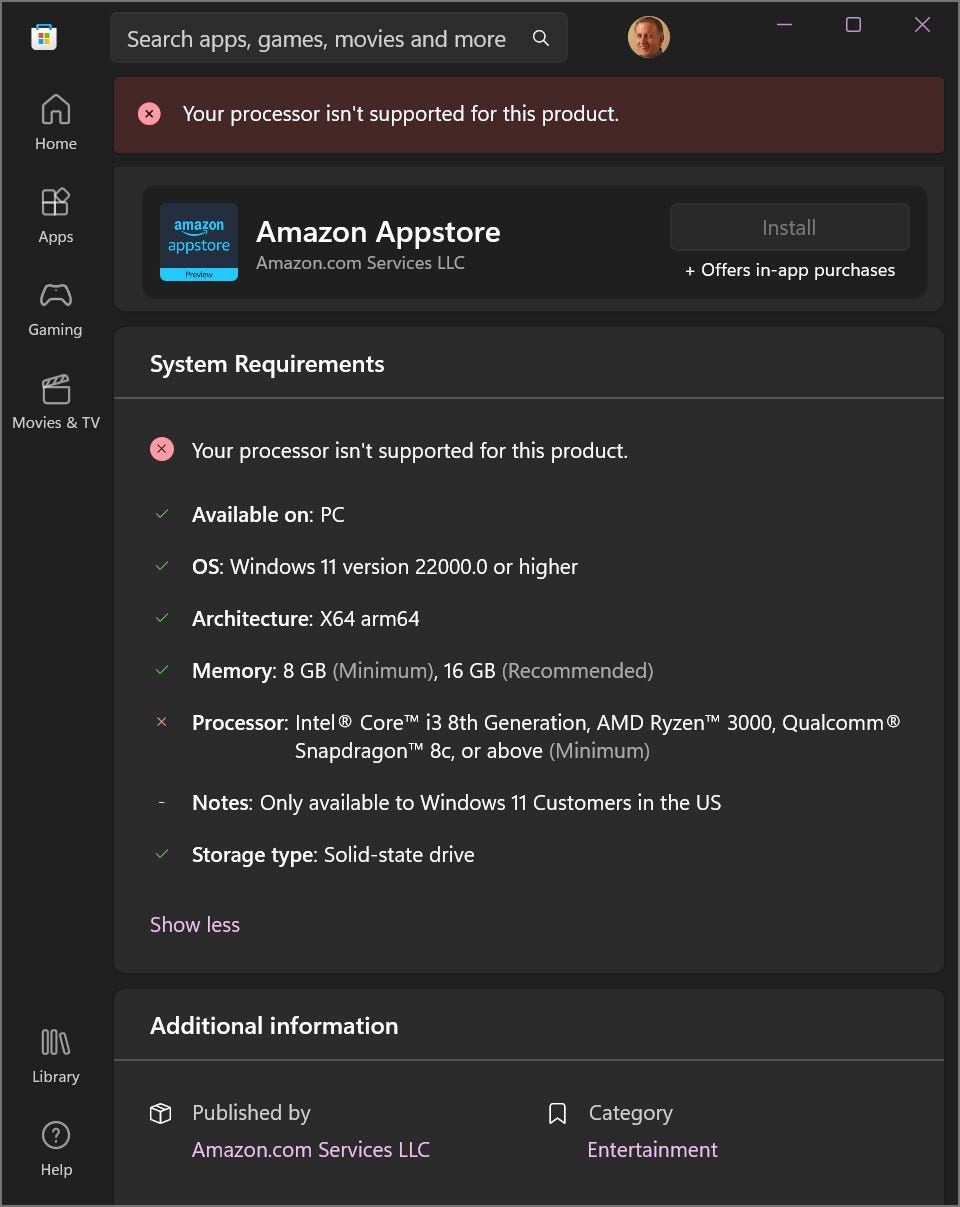
The compatibility section of this store listing will alert you to compatibility issues.
As shown in the screenshot above, I was unable to install the necessary components on a Surface Go 2; its 8th Gen Intel M3 processor is good enough to run Windows 11, but it doesn’t meet the upper compatibility bar for the Android subsystem.
I was also unable to install the Android bits in a Hyper-V virtual machine, even after enabling nested virtualization. The compatibility checker complained that the virtual hard disk was not an SSD disk and refused to complete the installation.
I had more success on a variety of Dell laptops and Surface devices, including the Arm-powered Surface Pro X, which handled the workload exceptionally well.
How to install Windows Subsystem for Android?
The installation process is, thankfully, straightforward. First, make sure the Microsoft Store app is updated; then install the Amazon Appstore app, which automatically enables the Windows 11 virtual machine platform and installs the Windows Subsystem for Android Components in the background.
Once the installation is complete, you will find two new shortcuts in the Windows 11 Start menu, one for the Amazon Appstore and another for the Windows Subsystem for Android Settings app. This latest app gives you some control over how the Android virtual machine uses system resources.
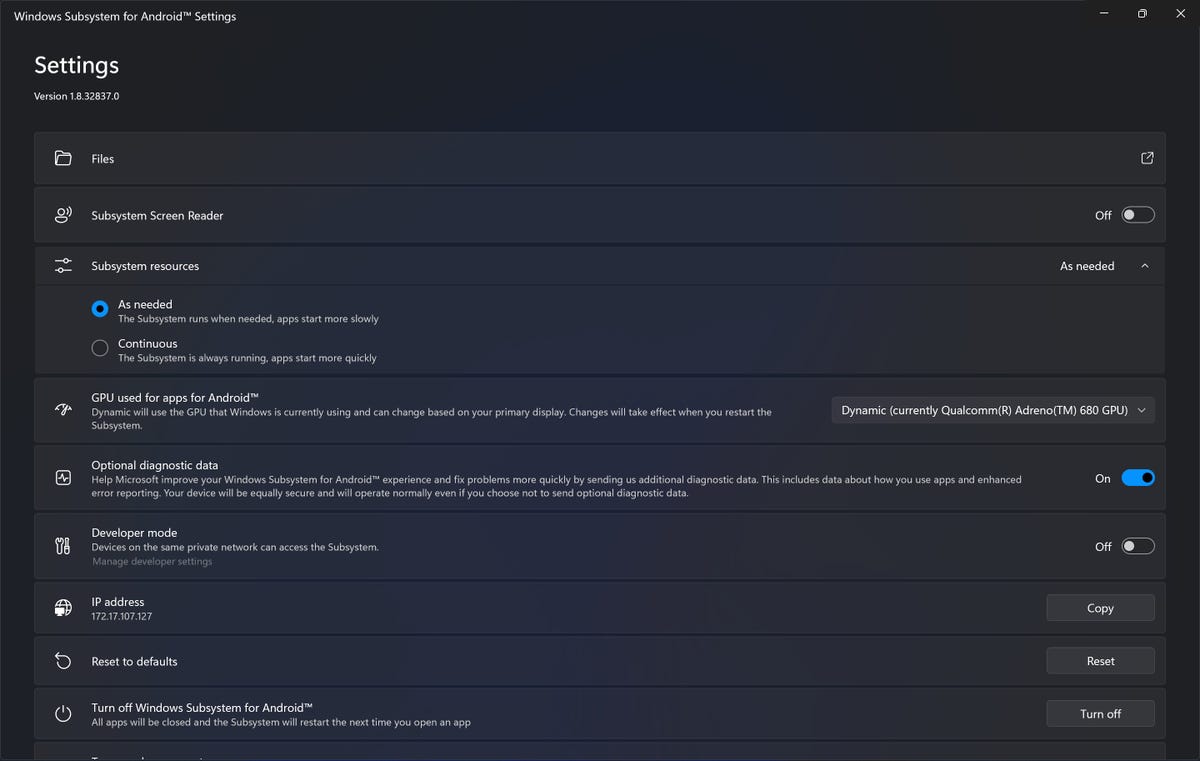
Use this app to adjust resource usage for Android virtual machine.
How much memory and disk space does the Android subsystem use?
On my test system, installing the Android subsystem used about 1.3 GB of storage for the app and associated components; installing the Kindle app and downloading a few books took up an additional 1.3 GB of disk space.
In operation, the Android virtual machine and running applications use a significant amount of memory, which could explain why Microsoft indicates that 16 GB of RAM is recommended for this configuration.
You can use Task Manager to monitor memory usage for Windows Subsystem for Android. As you can see from this example, taken from the Surface Pro X with 16GB of RAM installed, the Android VM itself gobbles up well over a gigabyte of memory, and the Kindle app plus its data file carries total usage to more than 2 GB.
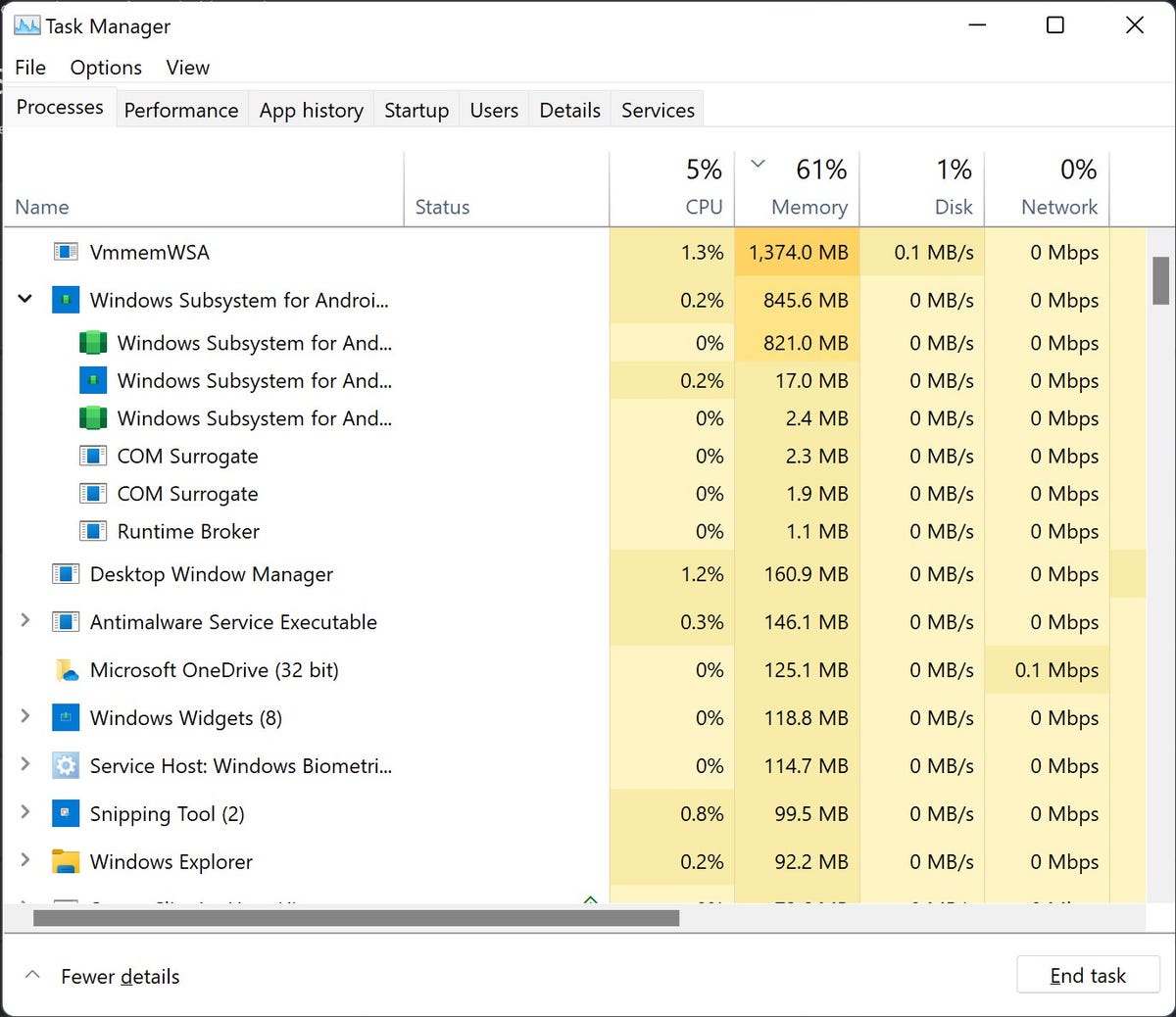
Android apps run in a virtual environment that uses a significant amount of memory.
How do I uninstall Windows Subsystem for Android?
To uninstall Android components and reclaim the disk space they use, open the Windows 11 Settings app, navigate to Apps > Installed apps, and scroll down to the Windows Subsystem for Android entry. Click the three dots to the right of the menu entry, then click Uninstall.
Note that uninstalling Windows Subsystem for Android also uninstalls the Amazon Appstore and any Android apps you have installed.
Is all this worth it?
The Windows Subsystem for Android was designed for use on touchscreen tablets, not keyboard-and-mouse-driven PCs. The Kindle app running on a Surface device with a detachable keyboard is where this design succeeds. You can arguably take a single device on the road and use it for reading, entertainment, and running productivity apps in this configuration.
But that’s about the only success of this first version of Android on Windows. The selection in Amazon’s Appstore is paltry, and it’s hard to imagine that every developer with top-notch Android apps will be incentivized to upload them to Amazon’s store so they can run on a tiny minority of Windows devices.
This scenario might have been more sustainable in a world where Windows ran on smaller tablets, but Microsoft pretty much killed this form factor after the Windows 8 debacle.
So for now the Windows Subsystem on Android is mostly just a proof of concept. Microsoft couldn’t crack the code to convince developers to write native apps for its Windows tablets, and it’s hard to see anything here that makes a more compelling argument.
As always, the correct answer is probably to wait for version 3.

